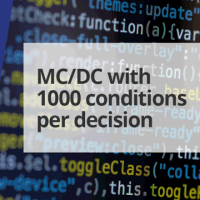If you’ve managed to get to 100% MC/DC, does that mean you’ve tested 100% of your requirements?
Remember that 100% MC/DC means that all of the Boolean decisions have been exercised and that entry and exit of each function has been covered. Requirements will typically govern input-output relationships for the whole function. For example, consider the function:
int perc_mix( int perc, int p0, int p100 ) {
int result;
if( perc < 0 ) {
result = p0;
} else if( perc > 100 ) {
result = p100;
} else {
result = ((p0 * perc) / 100) + ((p100 * ( 100-perc )) / 100);
}
return result;
}
And its requirements:
1: at perc=100 or over, return p100
2: at perc=0 or below, return p0
3: at perc between 0 and 100, return a linear weighted mean of p0 and p100, with the weight p0=1, p100=0 at perc=0 and p0=0, p100=1 at perc=100.
A test suite of perc=-50, perc=0, perc=100, perc=150 achieves full MC/DC but does nothing to exercise requirement 3. (Hopefully the tests have been constructed with differing values of p0 and p100, so that the error in the else-branch of the implementation can be found.) To demonstrate that you’ve tested 100% of your requirements, you need to show:
- That you have a test for 100% of your requirements;
- That 100% of your tests actually test a requirement;
- That every test passes.
Notice that these can be achieved by review – MC/DC is not playing a part here.
So what is MC/DC doing? Once you’ve met the above conditions and you also achieve 100% MC/DC, you will know that your tests have exercised all of the decisions and conditions in your application.

 Hybrid electric pioneers, Ascendance, join Rapita Systems Trailblazer Partnership Program
Hybrid electric pioneers, Ascendance, join Rapita Systems Trailblazer Partnership Program
 Magline joins Rapita Trailblazer Partnership Program to support DO-178 Certification
Magline joins Rapita Trailblazer Partnership Program to support DO-178 Certification
 Eve Air Mobility joins Rapita Systems Trailblazer Partnership Program for eVTOL projects
Eve Air Mobility joins Rapita Systems Trailblazer Partnership Program for eVTOL projects
 How to certify multicore processors - what is everyone asking?
How to certify multicore processors - what is everyone asking?
 Data Coupling Basics in DO-178C
Data Coupling Basics in DO-178C
 Control Coupling Basics in DO-178C
Control Coupling Basics in DO-178C
 Components in Data Coupling and Control Coupling
Components in Data Coupling and Control Coupling
 DO-278A Guidance: Introduction to RTCA DO-278 approval
DO-278A Guidance: Introduction to RTCA DO-278 approval
 ISO 26262
ISO 26262
 Data Coupling & Control Coupling
Data Coupling & Control Coupling
 Verifying additional code for DO-178C
Verifying additional code for DO-178C
 DO-178C Multicore In-person Training (Bristol)
DO-178C Multicore In-person Training (Bristol)
 DO-178C Multicore In-person Training (Fort Worth, TX)
DO-178C Multicore In-person Training (Fort Worth, TX)
 DO-178C Multicore In-person Training (Toulouse)
DO-178C Multicore In-person Training (Toulouse)





















